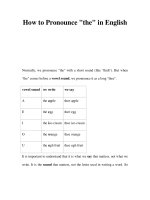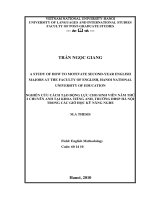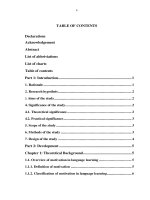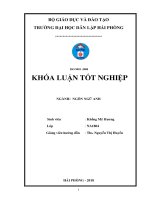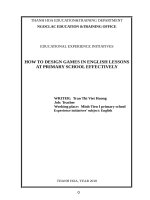How to desingn games in English lesons at primary school effectively
Bạn đang xem bản rút gọn của tài liệu. Xem và tải ngay bản đầy đủ của tài liệu tại đây (133.71 KB, 19 trang )
THANH HOA EDUCATION&TRAINING DEPARTMENT
NGOCLAC EDUCATION &TRAINING OFFICE
EDUCATIONAL EXPERIENCE INITIATIVES
HOW TO DESIGN GAMES IN ENGLISH LESSONS
AT PRIMARY SCHOOL EFFECTIVELY
WRITER: Tran Thi Viet Huong
Job: Teacher
Working place: Minh Tien I primary school
Experience initiatives’ subject: English
THANH HOA, YEAR 2018
CATALOGUE
Contents
Catalogue
1.Introduction
1.1.The reason of choosing the topic
1.2.Research purpose
1.3.Research subjects
1.4.Research method
2.Content initiative experience
2.1.The theoretical basis of initiative experince
2. 2 . The situation of the problem
2.3. The solution used to solve the problem
Page
1
2
2
2
2
2
3
3
3
5
2.4 . Effectiveness of initiative experience
3.Conclusion
12
3.1. Conclude.
13
3.2.Suggest.
13
15
REFERENCE MATERIALS
CATALOGUE OF THE INITIATIVE EXPERIENCES
CHOSEN FROM THE GRADES OF EDUCATIONAL
13
16
SCIENTIFIC DEPARTMENT
1. INTRODUCTION
It has been common knowledge that English plays an important part in
our life. Due to English, we can widen our knowledge to communicate with
people all over the world. Because of its importance, our education and
training department decided that Engish is a main subject from primary to
2
university grade. However, It is very difficult to teach and learn English in
primary school, especially in the countryside and moutainous places.
For most of things, I know the importance of inspirating desires of
learning English for our fresh men, so I have always tried to find the best ways
of teaching to stir my lessons by using some suitable games which make our
pupils be keen on their new language and lead them to achieve their new
knowledge through lessons actively. Through games children are easy to
learn,Team games encourage children to work together. Moreover, they use all
their senses when they play games,Children can use the knowledge they
already have about rules and their roles in a game.
With those criterias, during the past few years, I have successfully
applied my experienced initiatives which I courageously write and show out
to share with my honorable readers about the topic: “How to design games in
English lessons at primary school effectively”. In the course of research, I
believe that there will still be some errors, I hope to receive comments and
advice from my leaders as well as colleagues .
1.1. THE REASON OF CHOOSING THE TOPIC.
In real life, children learn through playing. Therefore, using games in
English classs can help children’s language learning. Moreover, games create a
child - friendly learning environment which help Teachers have more chance to
develop their pupils’speaking skill – this is the most important skill for new
beginners. From my thoughts and experiences above I research this topic.
1.2. RESEARCH PURPOSE.
When I write this idea, I would like to contribute my small part to
motivate Primary pupils feel like learning this second language and gain better
grade.
1.3. RESEARCH SUBJECTS.
In my topic, I just focus on how to use games suitably in each unit of
knowledge, such as: Some games focus on vocabulary & fluency, some
reinforce accuracy or build up model senences……
1.4. RESEARCH METHODS.
1.4.1. Research, kinds of English tests to find out which can assess the
qualifications and the knowledge of the students without any pressure.
1.4.2. Research based on observation methods: attending worshops
about techniques of teaching primary pupils. Or classes of my colleagues.
1.4.3. Research based on practice: Teaching with the attendance of some
colleagues then discuss to learn from each other.
1.4.4. Research based on studying materials related to designing games
for primary lesson.
2. CONTENT INITIATIVE EXPERIENCE
2.1. THEORETICAL BASIS OF INITIATIVE EXPERIENCE
3
The fact is that Children are not old enough to be able to understand or
analyse the structure of a tense or other grammars that make them so confusing.
In the past I taught some primary classes about model sentences and ask them
to explain the usage again but it seemed to me that most of them couldn’t
acquire.
What I taught made my lessons rather boring. So I think Teachers
shouldn’t only teach basic knowledge in textbooks because learners will be
passive and they will not feel confident as well as not flexible to adapt with
changing daily life.
In the past few years methods of teaching have been changed to be with
the development of society and communicative method has been used .It means
that in lessons pupils are centered to develop their creations and activeness
through different activities. Therefore, suitable games in lessons are the best
choice .
2.2. THE SITUATION OF THE PROBLEM.
2.2.1. Advantages
2.2.1.1. On the part of teachers
-Nowadays, there are so many textbooks , tapes or videos that provide
kinds of games to motivate children to learn English. Besides, Teachers are
sometimes attended workshops that encourage Teachers to use games to
consolidate knowledge.
- Have to access and use of new methods in teaching.
- Creativity, learn some appropriate teaching compatible with the content
of the lecture.
- Teachers use modern equipment well such as computers, speakers,
projectors,...
-Teachers should use bodylanguage in teaching if necessary.
2.2.1.2. On the part of students
- The majority of school students are eager to be taught this new language.
- They are very active and so industrious.
2.2.2. Disadvantages
Besides the above advantages, teachers and students exist back:
2.2.2.1. On the part of teachers
Teachers also use several methods that are not child –friendly for primary
pupils , so children sometimes don’t know the reason why they have to learn the
lessons which make teaching and learning no meaningful.
2.2.2.2. Teaching equipment
Equipment used for teaching English is limited. Some equipments are
spoiled or outdated inconsistent with teaching. More importantly, there is no
function room which is also a challenge with Teachers to organize a game
without any noise to classes around
2.2.2.3. On the part of students
4
Pupils have no chance to practice at home because there is no English
environment around them. So schooltime to learn English is rather
little.Moreover, some children are shy to communicate in English.
Before applying the games in lessons, I took a class survey to see the
differences. I chose class 4A at Minh Tien 1 primary school with total pupil is
31 to do a small test after learning theme 1(from unit 1 to unit 4):
This is the result before I apply the experience initiative:
Result of before applying the experience initiative
N G
Excellent
Good
Fair
Weak
attitude
To
o ra
like dislike Hesit
de tal
ation
SL
1
4
A
31
6
%
19
S %
L
10 32
S %
L
11 36
S
L
4
% SL/
Sl/
%
%
1 11/36 6/19
3
Sl/
%
15/4
5
QUESTIONS OF A SMALL TEST
PART - READING
Question 1: Read and match .1p
1. What nationality are you?
A. Yes, I can.
2. Can you cook?
B. It’s on the fifth of November.
3. What day is it today?
C. It’s Monday.
4. When’s his birthday?
D. I’m Vietnamese.
* Answer: 1 ;2; 3; 4.
PART -writing
Question 2: Fill in the blanks. 1p
1. Am _ rica
2. We _ nesday
3. M _ rch
4. s _ im
Question 3: Reoder the words to make meaningful sentences. 2p
1. is / today / What / date / the / ? -> …………………………………
2. I / volleyball / can / play / . -> ………………………………………
3. What / you / on / do / Tuesdays / do / ? -> …………………………..
4. from / Linda / is / England. -> ……………………………………….
* After finishing this test I did a survey to ask their attitudes :
I ask:do you like this test?you tick “ x” in one of the squares :
like
dislike
hesitation
*Comments after checking: the result of the survey showed that primary
pupils felt so bored to do exercises ,they were not keen on the subject,They had
difficulty in practising both at home and at school and it seemed to me that they
had no reason of learning .
2.3. THE SOLUTION USED TO SOLVE PROBLEMS
2.3.1.Using games in lessons to build up students’ skills:
5
The fact is that children love games and are always inventing new games
to amuse themselves.Using games in class is a natural way for children to learn.
For example ,to practice vocabulary and pronunciation,we can play games
which focus more on accuracy.This type of game require children to remember
and repeat words and phrases.These games are more controlled and fluency
practice games because we want the children to be more accurate in their
language use
In both fluency and accuracy practice.It is important that games help
children to use chunks of language and not just single words or sounds. Playing
games really helps children improve vocabulary, pronunciation and grammar in
a fun way but it is important that your games have a clear language focus.Before
class,you need to prepare games carefully to make sure that they provide good
language practice.
2.3.2 .How to design games in English lessons:
It’s important that games must be suitable with the contents of each
lesson, it means that Teachers must choose which games focus on
grammar,vocabulary, Fluency, accuracy or so on
Games are so meaningful and ceate a child–friendly learning invironment.
Games are suitable with Teachers and Pupils as well as school’s facilities.
Games wake up all children’senses, develop their creations, attract their
attention, And enhance learning.
2.3.3 Learning games’structures:
-Name of the game
-Aims of the game:
To practice or revise which skill(vocabulary,fluency or accuracy…)
-Game’s materials: Describe kinds of things used to play games
-Number of players:how many people can join in a game.
-Rules of games:
*First of all,get your pupils’attention before you start giving out the
instructions.
*Plan what you are saying.
*Give short instructions
*Make sure your instruction are in alogical order,using such signposts as
first,second,next…..
*Always demonstrate what the students should be doing.
*Check that students understanding before starting, Short and simple
instructions together with gestures are more efficient.
2.3.4 How to play games:
- Allowed time: from 5 to 7 minutes.
-How to organize: First,Teacher introduces name of the game, guide
pupils to play by modeling the games(should be twice).This is a very good way
of helping children to learn and remember rules of the games so they don’t have
to remember long and difficult spoken instructions.
6
-Start playing game: Pupils are participants and Teacher plays as a referee.
-Teacher gives comments about results of game: Pupils’attitudes,mistakes
should be avoided, or knowledge they have just practiced.
-After the game:Teacher should give reward for the winning team , it may
be aclap,points,songs,sweets,pens…Which motivate children to learn better,
besides If someone breaks rules of a game, Teacher should give them a child –
friendly punishment such as: run one leg, dance or sing a song…It’s important
that Teacher must be fair which makes children feel comfortable and ready to
receive any punishments if they lose a game.
2.3.5 Introduce some games for types of practicing skills at primary
classes:
I would like to introduce some games I have ever applied in my lessons:
Game 1: Body labeling
Materials:
-A white board
-14 sticky labels (or ‘post-its’ ) for each group of 4 or 5 students.
-A3 size paper for each group (option-see below)
Head
Arm
shoulder
eye
hand
nose
mouth
finger
body
leg
toe
foot
knee
thumb
Aims of the game: to build children’s pronunciation and grammar
Procedure:
1. Use flashcard to teach or review the target vocabulary. Check that the
children know the words to practice pronunciation.
2. Write the words from the box above on the white board, eliciting the
vocabulary from the children.
3. Put the children into team of 4 or 5.
4. Give each group 14 sticky labels. Students write one different word on
each label.
5. Option A One child from each group is selected to be the ‘body’.The
other children in the group put the sticky labels on the correct part of the
body.The winning team is the first to stick the label to all correct body parts.
When they stick the label to the body part ,the children have to say:here’s the
mouth , here’s the toe etc .
6. While the children are playing, monitor and check which words the
children can’t remember or any problems with pronunciation .
7. At the end of the game , check the meaning of the words and practice
pronunciation with the whole class .You can do this by having a drawing of a
body or skeleton on the whiteboard. Point to a body part and the class shouts out
what it is. Drill the pronunciation of the word. Then write the word next to the
7
body part.Repeat this for the words which children had problems with while
playing the game.
8. Recording:Ask children to draw a skeleton or body in their vocabulary
note books and label the body parts.
Important note:
This game is great fun , and good for energizing pupils. However , if you
feel that it’s not appropriate to use the children themsves as the body , then you
can use Option B for stage 5 of the game:
Option B: Give each group an A3 piece of paper and ask them to draw a
skeleton or human body (or prepare one for each group yourself before the
lesson) . Each group sticks the labels on the correct part of the skeleton or body
on the piece of paper. The winning team is the first to stick the notes to correct
body parts.
After the game :Teacher congratulates the winner and gives reward for
the winner such as :a clap or candy…
Game 2 : The skeleton game
1
2
3
4
5
6
7
8
Materials:
- A white board
- A set of written instructions (see below ) and one dice for each pair of
children
- A4 size paper for each child. Children play this game in
pairs.
8
Aims of the game: to build children’s pronunciation and consolidate their
vocabulary.
Procedure:
1 .Prepare a handout with the following instructions and give one to each
pair of children (or show the onstructions on the white board ):
Play this skeleton game with a friend :
Instructions:
• Roll the dice. You must get 1= a body to begin
• When you get 1, draw a body on your paper.
• Take turns, roll the dice and draw the
different parts of the body on the skeleton.
Don’t forget ! you must have a body before you can
draw the shoulders , arms , legs or neck; you must
have a head before you can draw the eyes, ears , nose
and mouth !
• The first person to finish his/her skeleton is the
winner !
1=body , ear
2= head , eye
3= neck , shoulders
4= arm , nose
5= leg , mouth
6=hand , foot
1. Read the instructions with the children. Model the game first and check
they understand what to do , eg. Demonstrate how to play the game to the whole
class, The children in each pair take turns in throwing the dice and then drawing
a body part. The winner is the first child to complete the skeleton with all the
body parts.
2. Before the children play ,teach them useful functional language they
need to play the game and let them practice repeating this language . Eg. “you
start”,“It’s your turn “,”A five, good! I can draw a leg .”; “ oh ,no! I can’t draw
anything.”; “I’ve finished!”
While the children are playing ,monitor and note any problems with the
meaning of the words or pronunciation.
3. At the end of the game ,spend sometime checking meaning of words ,
or practicing pronunciation .
After the game: Teacher congratulates the winner and gives reward for
the winner such as: a clap or candy…
Game 3: Bingo
Materials: A black board
Aims of the game: A great game for practicing/ reviewing almost any
language area, for very young children you could use this game to revise letters
of the alphabet.
9
For older learners, you could make it more challenging by giving
definitions of words instead of just the words.
Procedure:
1. Draw a word grid on the board and ask pupils to copy it
2. Have them the words they have learnt in their lessons.
3. Lists the words on the board.
4. Each pupils chooses nine words from the lists to copy into their grid.
While they are doing this ,copy each word onto a piece of paper
5. Put the pieces of paper into a bag and mix them up.
6. Select pupils to pick out a piece of paper and call out the word. Pupils
with that word in their grid can cross it out.The quickiest pupil to cross out an
entire row of words in their grid and call out Bingo is the winner
.Alternatively , you can continue the game until one pupil has crossed all the
words.
After the game :Teacher congratulates the winner and gives reward for
the winner such as: a clap or candy…
Important note :
A great game for practicing/reviewing almost any language area. For very
young children you could use this game to revise letters of the alphabet.
For older learners, you could make it more challenging by giving
definitions of words instead of just the words, Eg, teacher says “this shop sells
bread and cakes”. The children have to cross out “the baker’s”.
Game 4: Bees find words
Materials:
-Two flowers with 5 petals, each flower has different colours, each petal
has different numbers and sides behind sticked with magnet
1
10
3
6
7
4
9
8
2
5
+ 10 bees written words and sides behind sticked with magnet:
one
four
six
two
seven
five
nine
ten
eight
three
+ colourful chalks.
Aims of the game: To check children’s vocabulary, create exciting
atmosphere to learn in class.
Procedure:
10
- Choose two teams , each team has 5 members. Teacher devides the
board into two parts, each part has a flower and five bees arranged disorderly,
then introduce name of the game: I have two flowers , there are numbers on
each pental, there are words on each bee. Your task is to lead the bee go with the
word.
Two teams stand in two down lines, when you hear “start”, you quickly
match the bees with the words correctly. you do inturns intil the last member.
The fastest team with the most correct matching is the winner.
After the game: Teacher gives reward for the winner such as: A clap or
candy…
Notes: You can change numbers in pentals in English and viceverse.
Besides, There maybe a word not suitable on each pental and find the way for
bee to go with words and how to change.
Game 5: Pastimes
Materials : There’s no need any preparation.
Aim of the game: To check children’s vocabulary, create exciting
atmosphere to learn in class.
Procedure:
Teacher draws two suns with rays of sunrise,devide class into two teams,
give each team a chalk to write on the board any word ,then quickly give chalk
to an other member in team.
When children hear “start”, each member of the team quickly writes on
the board any word, only one word a turn , you can write two or more times.
Then move to other members of their team. The game finishes from 3 to 5
minutes.
After the game :Teacher congratulate sthe winner and gives reward for
the winner such as: A clap or candy…
Notes: If there are the same words in each team, they only get one word.
Game 6: Simon says……
Materials: There’s no need any preparation.
Aim of the game: This is a classic and fun game. You can play this game
to revise the target grammar and /or vocabulary items with pupils.
Procedure:
The teacher (or a pupil) instruct the class to carry out actions by saying
,for example, Simon says turn right or Simon says turn left. If the teacher doesn’t
begin the instructions with Simon says, pupils shouldn’t follow the instruction.
Anyone who fails to follow an instruction preceded by Simon says, or
follows an instruction not preceded by Simon says, is out of the game. The last
pupil who remains is the winner.
After the game: Teacher congratulates the winner and gives reward for
the winner such as: A clap or candy…
Game 7: Slap the board
Materials: A black board or rolled – up newspapers.
11
Aim of the game: This is a fun game which reinforces the association
between written and spoken words.
Procedure:
Teacher devides class into pairs and line them up. Give three of the pairs
each a rolled –up newspaper .Put flashcashs of the target vocabulary on the
board, or write it on the board directly. Call out a word and the three pairs
should slap the corresponding word or picture on the board. The quickest pair to
slap the correct word/ picture stays in the game and will play with another two
pairs of pupils. The pair which remains till the end of the game is the winner.
After the game: Teacher congratulates the winner and gives reward for
the winner such as: a clap or candy…
Game 8: Kim’game
Materials: A piece of cloth, collect a group of items of the same type,
e.g.fruit.
Aim of the game: This is a memory game for revising vocabulary
Procedure:
Teacher arrange the items on a desk and cover them with a piece of cloth,
without pupils seeing them. Have a brief discussion with the class on what might
be under the cloth, based on the shape and size of what they can see.
Divide the class into groups. Show the class the items under the piece of
cloth for 60 second. Then cover the items again and ask each group to write
down the names of as many objects as they can remember. Groups get a point
for each correct item. The group with the most points wins the game.
After the game: Teacher congratulates the winner and gives reward for
the winner such as :a clap or candy…
Game 9: Physical line - up
Materials: Slips of paper with target sentences on. Then cut each of them
into halves and put all slips into a box.
Aim of the game: This is a structure/ grammar game.
Procedure:
Teacher asks each of pupil to draw a slip of paper from the box.(The
number of pupils should equal the number of slips in the box). They should
show the paper to the others and try to find the matching sentences halves, stand
next to each other, and say the sentences aloud. The quickiest group to say the
correct sentence wins a point. You may ask pupils to put the slips of paper back
into the box and start the game again.
After the game: Teacher congratulates the winner and gives reward for
the winner such as: A clap or candy…
@ Progressions of teaching initiatives experience:
- To base on the result of a children’s test ,I’m aware of disadvantages
and restrictions of teaching and learning ,So I’ve studied to find new methods
to teach primary children and I try to gain my three main aims:
*First: To help students understand and remember easily.
12
*Second :Create children’s excitement and concentration.
*Third: Children can learn actively and creatively, they are centered to
practice more often in class.
-Here are some contents and guidelines to conduct some games in class:
Primary pupils are beginners to English, so Teacher should inspire the
excitement of learning English to them.
It means that every sentence should be so simple and child-friendly which
make them be keen on learning, be active and develop their intelligence. They
can learn through games. Therefore, it’s necessary to design games in lessons.
However, games must be suitable with contents of learning.
2.4 EFFECTIVENESS OF INITIATIVE EXPERIENCE.
During the process of teaching English through games, I have realized
effectiveness of an English lesson; Children become absorbed in the games
really enhance learning, playing games gives children a real reason to use
language to communicate with each other, children use all their senses when
they play games, Using different approaches makes learning more memorable
and appeals to different ways of learning, children can use the knowledge they
already have about rules and their roles in a game. Moreover, team games
encourage children to work together and communicate with each other; again
helping to increase fluency. The fact is that games have a final outcome – this
means children are using language to do some thing which is more motivating
and memorable than practicing language for its own sake. Besides, games are
easy to learn –children can usually learn and remember the rules of games easily
. This means you can use the same game again to practice different language and
the children will remember how to play the game .
The effectiveness of teaching initiatives is assessed through the survey of
children’s learning result and their attitudes.
Please see below the result of evaluation before and after applying
games in English lessons in class 4A- at Minh Tien 1 primary school:
Class
( total)
4A(31)
Knowledge level
classi
ficati
on
Excel
lent
Attitude
before
after
Attitude
before
after
8
(25,8%)
13
(42%)
Like
11
(35,5%)
20
(64,5%
13
Good
)
2
(6,5%)
9
(29%)
7(22,5%
)
13(42%)
15
Dislike
7
(48%)
(22,6%)
Fair
2
Hesitation
13
(6,5%)
(41,9%)
Weak 3(9,7%)
1(3,5%)
After choosing and applying some games in my lessons, I saw their
excitementand absorbabilities in learning, they feel more confident in
communicating in English. Especially, They are eager to wait for my English
lessons.
3. CONCLUSION
3.1. CONCLUDE.
From my point of view: “How to design games in English lessons at
primary school effectively ” is a process to use some tactics to help children
consolidate their knowledge and improve their English kills as well as
enhance their inspiration in English. However, Teachers should be flexible to
adjust their lessons to make it suitable with each class ,besides Teacher should
give clear explanations, keep it so short and simple which will bring the best
result.
However, My initiative experience is likely to have some mistakes, I have
still adjusted during my teaching, and I need to learn from my colleages, so It
will be grateful if I receive any comments from my honorable readers.
I hope my initiative experience will be an effective method to motivate
primary pupils to learn English better. This will help Teachers apply the
communicative method successfully.
3.2. SUGGEST.
3.2.1. For the school managing board.
-English is a typical subject, Teachers need to be equipped enough
teaching materials such as: Function room, cassette, tapes...So I hope school
leaders and local authority will pay attentionto our teaching conditions much
more, This will help teaching as well as learning English more and more
effective.
-Organize English club once a week with different topics to attract pupils
to learn English through songs, chants, games.....
-A worthy reward for teachers to teach effectively and the prizes in the
contest good students at district level, provincial level.
3.2.2. For the Department of Education and Training
-Organize workshops, improve the professional skills of teachers
throughout the district at the begining of every school year.
-Organize the meeting English speaking students to schools create new
inspiration in learning, and motivation for students.
14
-Our colleagues’experience initiatives of graded A in districts which are
chosen from the educational scientific department need to be widely popularised,
this will help us learn different good methods from each other to make our
lessons more suitable and more interesting.
Thanks a lot and best wishes!
Principal’s signature
Ngoc Lac, March 6th, 2018.
I declare this is my own work and
works of others. I am liable for any
copyright and plagiarism problems
related to this work.
Written by:
Nguyen Van Luong
Tran Thi Viet Huong
REFERENCE MATERIAlS
1. HUNG ANH –LAM UYEN Learning English through games (Educational
publishing house).
2. NGUYEN THI MAI HOA-Teaching English for Children through
themes(Educational publishing house).
3. NGUYEN QUOC TUAN-some of basical parts in teaching and learning
English (Educational publishing house).
15
4.British council learn English kids website: />5.British council teach English (www.teaching english.org.uk)
And learn English ( />6.British council .(2009). Motivating learning .
7.Cameron,L.(2001)Teaching languages for Young learners.Cambridge:CUP.
8.Carolyn,C(2006).Creating chants and songs.Oxford:OUP.
9.Hancook,M.(1998).singing grammar.Combridge:CUP.
10.Moon,J.(2000). Children learning English-A guidebook for language
teachers.MacMillan Publishers Limited.
11.Pasigna,L.A.,(1997).Tips on how to manage a large class,Institute for
International Research,Inc.
12.Read,C.(2007).500 Activities for the primaryclassroom.MacMillian
13.Scott,W.A&Ytreberg,LH.(1990).Teaching English to
children.Newyork:Longman.
14.Chin,J.(2009). Primary Teacher Traning Materials,US Embassy,HaNoi.
15.Wright, A.(1995).storytelling with children.Oxford:OUP.
16
CATALOGUE
THE INITIATIVE EXPERIENCES CHOSEN FROM THE GRADES OF
EDUCATIONAL SCIENTIFIC DEPARTMENT
Name of the writer: Tran Thi Viet Huong
Place of working: Minh Tien 1 Primary school
No
1.
2.
3.
Names of the initiative
experiences
Grades of
educational
scientific
department
Some methods of warm-up Ngoc
lac
educational
stage at secondary school.
scientific
department
Some methods of practice Ngoclac
educational
speaking English well for
scientific
grade 3 students.
department
How to practice speaking Ngoclac
educational
English well for grade 4
scientific
students.
department
17
Results of
School
the
years of
assessment. assessment.
B
2010-2011
A
2013-2014
B
2015-2016
18
4.
5.
...
19
